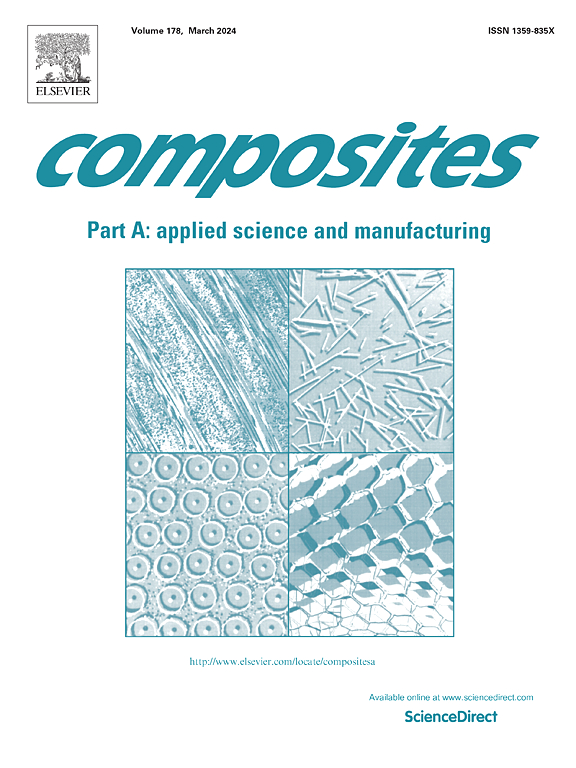Low-velocity impact response of carbon/epoxy laminates with interlaminar hybrid toughening via core–shell-rubber particles and non-woven thermoplastic fibre veils
IF 8.1
2区 材料科学
Q1 ENGINEERING, MANUFACTURING
Composites Part A: Applied Science and Manufacturing
Pub Date : 2025-04-16
DOI:10.1016/j.compositesa.2025.108944
引用次数: 0
Abstract
Advanced composites (e.g. carbon fibre-reinforced epoxies) have been increasingly used in lightweight, critical applications such as aerospace, renewable energy and defence industries due to their excellent mechanical properties including high specific strength, stiffness and fatigue properties. However, the inherent brittleness of polymer composites makes them vulnerable to low-velocity out-of-plane impact loading, threatening their structural integrity. In this context, enhancing the low-velocity impact resistance of composite laminates is crucial for maintaining their structural integrity and reliability throughout their service life. Therefore, this study explores the low-velocity out-of-plane impact resistance of composite laminates (i.e. consisting of the unidirectional non-crimp carbon fibre fabrics and low-viscous two-part epoxy resin) toughened with core–shell rubber (CSR) particles and thermoplastic veils. The CSR particles varying from 0.1 to 3µm and Polyphenylene Sulfide (PPS) fibre veils with a fibre diameter of µm were used to achieve non-hybrid and hybrid toughening. The impact response of the composite laminates, manufactured with vacuum-assisted resin infusion and out-of-autoclave curing, were characterised with drop-weight low-velocity impact testing in two energy ranges: near the delamination threshold (i.e. 2 J, 3 J, 4 J) and over a broader range (i.e. 2.5 J, 5 J, 7.5 J, 10 J). The results show that the toughening mechanisms derived from the hybrid use of PPS veils and CSR particles effectively enhance the impact resistance of composite laminates up to the delamination threshold. Additionally, the hybrid approach significantly reduces the projected damage area. However, beyond the delamination threshold, the influence of these toughening mechanisms on the impact properties is found to be limited.
通过芯壳橡胶颗粒和无纺热塑性纤维纱实现层间混合增韧的碳/环氧层压板的低速冲击响应
先进复合材料(如碳纤维增强环氧树脂)由于其优异的机械性能,包括高比强度,刚度和疲劳性能,已越来越多地用于轻量化,关键应用,如航空航天,可再生能源和国防工业。然而,聚合物复合材料固有的脆性使其容易受到低速面外冲击载荷的影响,威胁其结构完整性。在这种情况下,增强复合材料层压板的抗低速冲击能力对于在其整个使用寿命中保持其结构完整性和可靠性至关重要。因此,本研究探讨了用核壳橡胶(CSR)颗粒和热塑性薄膜增韧复合层压板(即由单向无卷曲碳纤维织物和低粘性双组分环氧树脂组成)的低速抗面外冲击性能。采用0.1 ~ 3µm的CSR颗粒和直径为9µm的聚苯硫醚(PPS)纤维膜实现非杂化增韧和杂化增韧。采用真空辅助树脂注入和非高压釜固化制造的复合材料层合板的冲击响应,通过两种能量范围的落锤低速冲击测试进行了表征:在脱层阈值附近(即2 J、3 J、4 J)和更宽的范围(即2.5 J、5 J、7.5 J、10 J)。结果表明,PPS膜和CSR颗粒混合使用的增韧机制有效地提高了复合材料层合板的抗冲击能力,直至脱层阈值。此外,混合方法大大减少了预计的损伤面积。然而,在脱层阈值之外,这些增韧机制对冲击性能的影响是有限的。
本文章由计算机程序翻译,如有差异,请以英文原文为准。
求助全文
约1分钟内获得全文
求助全文
来源期刊

Composites Part A: Applied Science and Manufacturing
工程技术-材料科学:复合
CiteScore
15.20
自引率
5.70%
发文量
492
审稿时长
30 days
期刊介绍:
Composites Part A: Applied Science and Manufacturing is a comprehensive journal that publishes original research papers, review articles, case studies, short communications, and letters covering various aspects of composite materials science and technology. This includes fibrous and particulate reinforcements in polymeric, metallic, and ceramic matrices, as well as 'natural' composites like wood and biological materials. The journal addresses topics such as properties, design, and manufacture of reinforcing fibers and particles, novel architectures and concepts, multifunctional composites, advancements in fabrication and processing, manufacturing science, process modeling, experimental mechanics, microstructural characterization, interfaces, prediction and measurement of mechanical, physical, and chemical behavior, and performance in service. Additionally, articles on economic and commercial aspects, design, and case studies are welcomed. All submissions undergo rigorous peer review to ensure they contribute significantly and innovatively, maintaining high standards for content and presentation. The editorial team aims to expedite the review process for prompt publication.
 求助内容:
求助内容: 应助结果提醒方式:
应助结果提醒方式:


